Tonix Pharmaceuticals stock halted ahead of FDA approval news
* Asian stock markets : https://tmsnrt.rs/2zpUAr4
* Futures point to gains in European, U.S. shares
* Massive fiscal and monetary stimulus offers lifeline
* Dollar holds big weekly gains, strains $ borrowers
* Oil firms after largest daily rally on record
By Wayne Cole
SYDNEY, March 20 (Reuters) - Asian shares made a partial
comeback from a global rout on Friday but still nursed massive
losses for the week, while bonds rallied and oil extended its
gains.
European shares were set for similar gains. Early in the
European day, pan-region Euro Stoxx 50 futures STXEc1 were up
1.87%, German DAX futures FDXc1 gained 1.86% and FTSE futures
FFIc1 .
U.S. S&P 500 e-mini stock futures ESc1 also pointed to a
brighter end to the week, adding 1.7%.
In afternoon trade in Asia, MSCI's broadest index of
Asia-Pacific shares outside Japan .MIAPJ0000PUS was 4.41%
higher, ending a seven-sessions streak of losses.
But in an indication of the deep damage inflicted on global
equities from pandemic fears, the index remains set to finish
more than 10% lower this week. It lost 11.1% last week.
As the spread of the coronavirus brought much of the world
to a halt, nations have poured ever-more-massive amounts of
stimulus into their economies while central banks have flooded
markets with cheap dollars to ease funding strains. The U.S. Senate was debating a $1 trillion-plus package that
would include direct financial help for Americans, relief for
small businesses and steps to stabilise the economy. Sources told Reuters that China was set to unleash trillions
of yuan of fiscal stimulus to revive an economy facing its first
contraction in four decades, though on Friday the country
surprised markets by keeping its lending benchmark unchanged.
"The speed and aggression with which authorities are
wheeling out measures to cushion the economic fallout from the
virus and sowing the seeds for a hopefully rapid recovery, has
resonated somewhat in equity markets," said Ray Attrill, head of
FX strategy at NAB.
"Yet there is little doubt that funds need to buy dollars to
rebalance hedges in light of the 30% fall in equity markets so
far this month," he added. "The dollar remains the pre-eminent
safe-haven asset during times of extreme market stress."
The dollar's surge is a nightmare for the many countries and
companies that have borrowed heavily in the dollar, leading to
yet more selling of emerging market currencies in a negative
feedback loop.
Such was the stress that dealers hear whispers of a new
Plaza Accord, the 1985 agreement when major central banks used
mass intervention to restrain a rampant dollar.
For now, investors in Asia were merely happy Wall Street had
not plunged again and South Korean shares .KS11 bounced 7.4%,
though that still left them down more than 11% for the week.
Australia's beleaguered market .AXJO eked out a 0.70%
gain, and futures for Japan's Nikkei .N225 were trading up at
17,710, compared to a cash close of 16,552.
OIL RELIEF
Aiding sentiment was a 25% rally in oil prices overnight.
U.S. crude CLc1 was 3.25% higher at $26.04 a barrel on
Friday, up from a low of $20.09, while Brent crude LCOc1 stood
at $29.14. O/R
This was a major relief as the collapse of crude prices had
blown a huge hole in the budgets of many oil producers and
forced them to dump any liquid asset to raise cash, with U.S.
Treasuries a particular casualty.
That was one reason yields on U.S. 10-year Treasuries
US10YT=RR had climbed over 100 basis points in just nine
sessions to reach 1.279%, before steadying a little at 1.1533%.
At the same time, funds across the world were fleeing to the
liquidity of U.S. dollars, lifting it to peaks last seen in
January 2017 against a basket of its peers =USD .
"Such price action suggests significant market stress,
particularly on the wide range of entities outside the U.S. that
have borrowed in dollars," said Richard Franulovich, head of FX
strategy at Westpac.
"It could last until global capital flows and investor risk
appetite normalises, possibly months away."
The euro rose 0.65% to $1.0759 EUR= but was not far off
three-year lows, having shed more than 3% for the week so far -
the steepest decline since mid-2015. The dollar did ease back
to 109.88 yen JPY= , but was still up nearly 1.9% on the week.
Sterling continued its wild swings with a rally to $1.1677
GBP= , having earlier hit its lowest since 1985 around $1.1404.
It was still down nearly 5% for the week.
The jump in the dollar has made gold more expensive in other
currencies. While it rallied on Friday to $1,494.48 per ounce,
it remains down about 2.5% on the week. XAU= GOL/
<^^^^^^^^^^^^^^^^^^^^^^^^^^^^^^^^^^^^^^^^^^^^^^^^^^^^^^^^^^^
Asia stock markets https://tmsnrt.rs/2zpUAr4
Asia-Pacific valuations https://tmsnrt.rs/2Dr2BQA
^^^^^^^^^^^^^^^^^^^^^^^^^^^^^^^^^^^^^^^^^^^^^^^^^^^^^^^^^^^>
